SPORTS SCIENTISTS ARE CONVINCED
The sportstation obstacle courses were developed with leading coaches from the world of soccer.
"I can unreservedly recommend the one-time or even regular use of the (sportstation) obstacle course to all sport clubs or schools for speed diagnostics or also as an attractive event in the framework of school or club functions"
„The (sportstation) obstacle course is motivating for children. On the one hand, the task is highly challenging; on the other hand, immediate feedback occurs via printout.“
Sports science explains the sportstation course:
Before the runner goes to the start, he should have warmed up his muscles in the context of prevention. After the technical procedure has been explained to the runner, he goes to the start. Depending on the sport type, he stands there, for example, behind a starting obstacle and focuses on an optical light signal. The moment the signal lights up, the electronic time measurement begins to run.
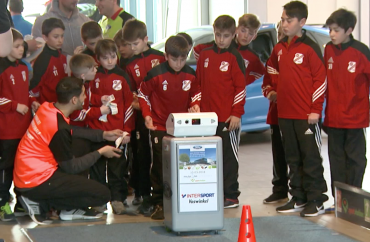
Reaction
From the perception of the light signal through the sense organ of the eye, there now follows the conduction of an impulse with the command to start the leg muscles. The starting process of circumventing the obstacle (this can be a fictional opponent, for example) and the first 1-2 steps is measured by the first photoelectric beam and serves as a measurement of reaction time. If too much time elapses here, one can speak of a “long conduction” in the truest sense of the word. In addition to measuring the reaction time as such, it is possible to distinguish between right and left. Since the athlete has to go around the starting cone to the right or left according to the light signal, it can be determined in which direction he reacts more quickly. A test series can show this.
To get a good reaction time, it is very important to bring the body into an optimal starting position. Decisive for this is the initial tension in the thigh muscles when the knees are flexed, in order to be able to start immediately when the brain gives this command. Poor reaction times are often caused by poor concentration. Here one can distinguish between external and internal factors. External factors can be, for example, the noise of big tournaments or the flash of a photographer. An internal factor would be thinking about something else or, for example, the perception of pain in part of the body. Targeted reaction training at the sportstation facility, along with high levels of concentration and optimal initial muscle tension, can bring noticeable and therefore measureable progress.
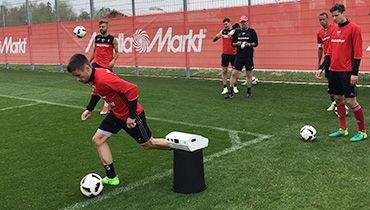
Initial speed
Running speed is measured on a short sprint distance of several yards. The decisive factor is therefore the ability to accelerate during the first steps. A good initial speed is characterized by small, powerful steps in a slightly bent posture. Especially on different ground surfaces, very different results are obtained in some instances. Due to the right-left distinction, it is possible to distinguish for the athlete after a few runs, which is the standing or jumping leg. For runs with the ball, a high level of accuracy is important to play the ball forward at the best possible pace.
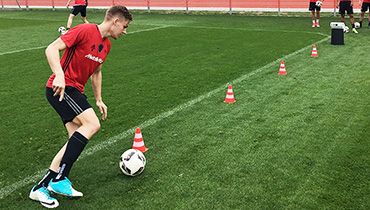
Turning speed
The turnaround is certainly the most difficult part of the whole course. Within a few yards, the body must be slowed down from high speed almost to zero, then a curve must be run, and then accelerated again immediately afterwards. If the run is done with the ball, it must be brought under control at exactly the right moment in order not to lose too much time.
On the basis of turnaround times, a conclusion can be drawn about coordination. Equilibrium plays a decisive role here. A run toward the left leads to a right turn; running to the right leads to a left turn. Frequently, large differences are apparent, which then allows conclusions to be drawn about lack of coordination. By training the weaker side, significant improvements can be achieved here. The experience shows that an athlete can, after some time, win or save up to 5-10 seconds at the turnaround.
IIn terms of turning speed, the ground surface plays a decisive role in combination with the weather. A quick turn on wet grass or a place with dry sand places very high demands on balance.
Training on the sportstation course with different ground surfaces relieves fears of a non-solid surface.
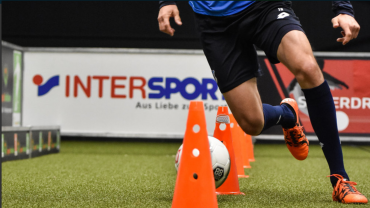
Return slalom
For a good return speed, it depends on how good the coordination of the athlete was at the turning point. If he lost his equilibrium, the return speed is strongly influenced. Of course, in terms of coordination, the return slalom is the most difficult part of the running course. Especially if this is done with the ball (for example, in the running game Superdribbler), there is an enormously high precision pressure, since every small error results immediately in elimination.
The combination of time pressure and precision pressure makes the return slalom so enormously difficult for runners of all ages, but also at all levels of play.
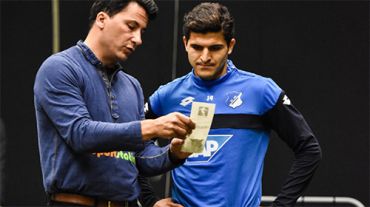
Total time
The different values of reaction time, initial speed, the turnabout and the different slalom times together result in a total time. If you compare different runs of the same runner with each other, and you always pick out the respective best results in the subtotals, you can show the runner directly what time is possible with training and concentration. This is a tremendous motivation that can release inner tensions and mental boundaries.
In summary, the following example shows the significance of the various sportstation evaluation possibilities: a tennis player often makes mistakes in the backhand volley. Normally, now the trainer is only discussing technique for the backhand volley. By means of the sportstation performance diagnostics, however, it can now be analyzed that the player reacts much worse on the left side or that there are deficits in coordination. Within the scope of training planning and training control, this leads to completely altered training content. The software can be individually adapted to different sports and corresponding running variations.
sportstation games

speed4
Compete with others in speed and coordination on the classic obstacle course.
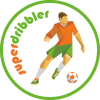
Superdribbler
This is all about your perfect footwork. Get the ball the fastest way through the obstacle course!

10-second run
In the 10-second run, it is important that you make the course in EXACTLY 10 seconds.

Paesen
Can you manage to run the course on the way back in exactly the same time as on the way out?


